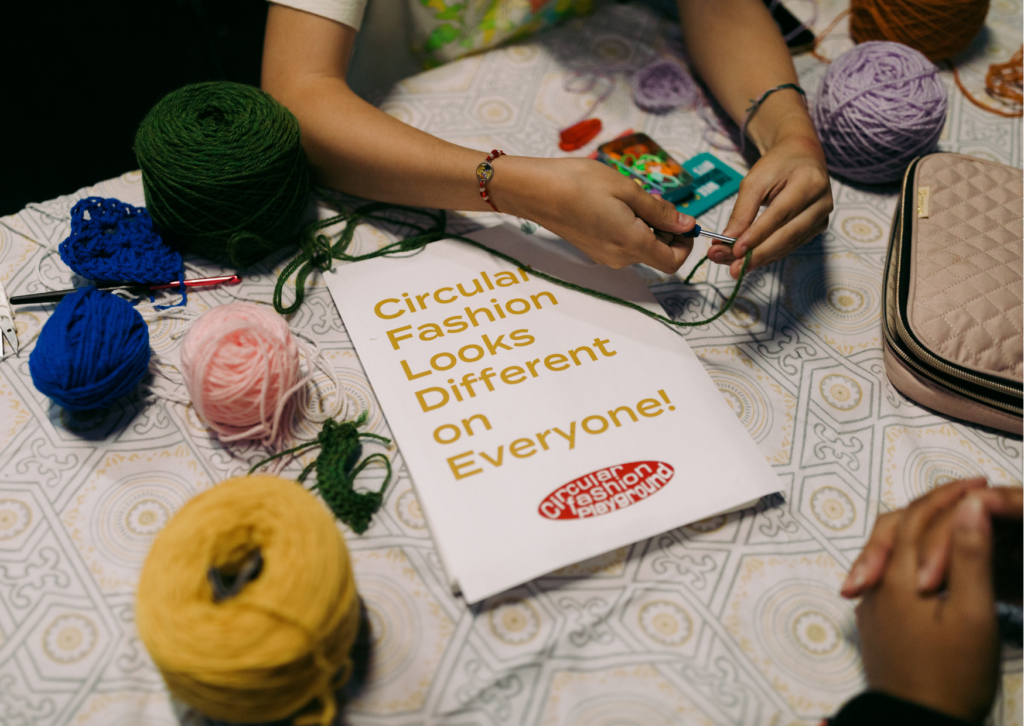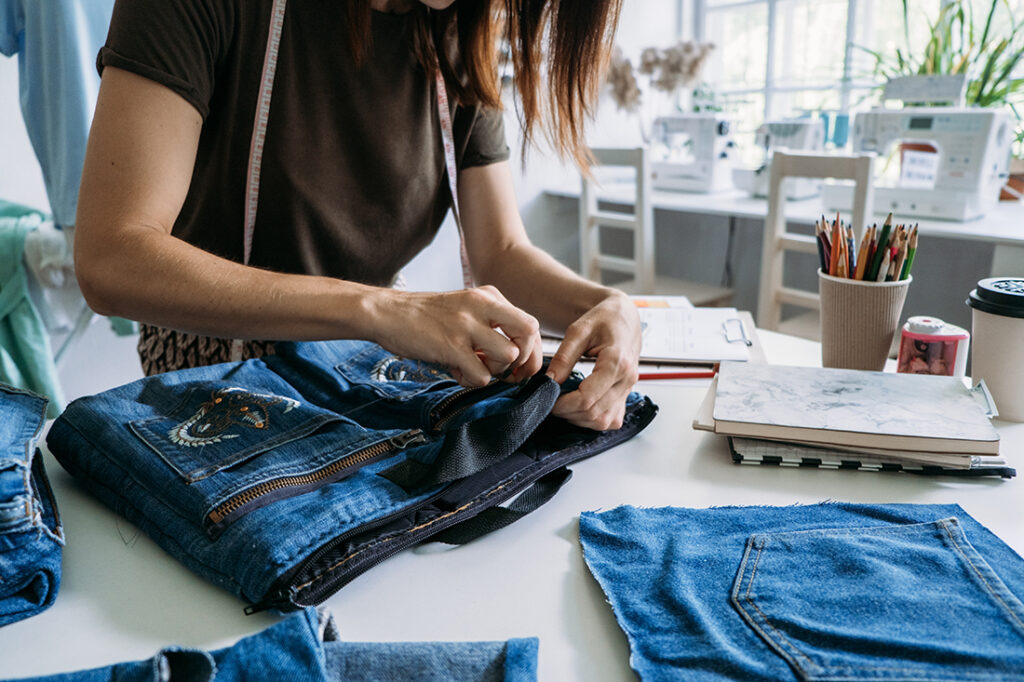Growing up, Rachel Ceruti had an appreciation for the environment, but she didn’t consider herself an environmentalist nor had she started upcycling clothes. Her awareness of environmental issues developed after her Peace Corps trip in Uganda, Africa. While she was there, she learned about how secondhand clothing is shipped to Africa and then ends up in landfills.
“We are, as a Western country, dumping on these developing economies and impacting their local economies. It’s now their issue to take care of these clothes that we produce and that we wore,” she says. “East African Community (EAC) actually banned secondhand clothes from coming into their countries because it was such a problem.”
Ceruti is now the founder and CEO of Reclypt, a company that’s focused on creating change through the circular economy, which means never wasting materials. There are many ways to eliminate waste, such as reusing, recycling and upcycling.
The main focus of her business is related to preventing textiles from ending up in landfills. “Textiles and landfills are incredibly harmful,” she says. “As textiles break down in landfills, which can take anywhere from a couple of months to 200 years, they are emitting greenhouse gases that are impacting our environment.” She also explains that polyester, which is one of the most widely used clothing fibers in the world, never fully decomposes.
What is upcycled clothing?
At its most basic form, upcycling clothing is taking old or damaged clothes and transforming it into something new. Upcycled clothes can be made from used or damaged clothes, unwanted textiles, clothing scraps from textile factories or surplus garments or fabrics (also known as “deadstock”) that would otherwise end up in landfills.
Upcycling is not only a way to repurpose fabrics and old clothes, but it can give a mix-and-match approach for designers with new items being refashioned from a combination of materials.
Exploring upcycled fashion
While attending various events in New York City, Ceruti learned about the sustainable fashion world. “I kind of fell into fashion. I have no fashion background. My style is just classic New Yorker dark colors,” she says. “Despite not really having a background in fashion, I knew that everybody wakes up in the morning and asks themselves, ’What am I going to wear?’” She explains that the answer to that question has so many implications to the environment, to social issues, to economies and politics—so that led to her exploring upcycle fashion.
Ceruti explains that upcycle fashion is when designers or brands use clothing that was going to be thrown away and then they make it into something new and elevated. When she first learned about it, she says her “mind was blown” since the clothing was a combination of artwork, creativity and fun. She began a blog about upcycle fashion, highlighting people in the field.
Building community through shared environmental interest
As her blog evolved, her community responded by saying, “We want to do the upcycling [and] we want to keep things out of landfills.” She then spearheaded mending clubs and clothing swaps.
“Mending clubs are when people come together to repair their clothes,” she says. “Swaps are when people bring clothes they don’t wear anymore and they exchange them for other people’s clothes.” Her business followed the same trajectory as the pandemic. When people began returning to in-person jobs, they were seeking a sense of community. People were, “seeking a third space, a place that’s not home or work or school—a place that you just go and there’s good conversation,” she says.

To help foster a sense of community, Ceruti added circular salons, which are meetings that promote discussions. Sometimes the circular salons are informal meetings, whereas other times the focus is on networking or book clubs. Her business also offers upcycle workshops. Last month, they had a yarn upcycling workshop wherein attendees brought sweaters to the event that they didn’t want to wear anymore with the goal of turning them into something that they would wear. She explains that they unraveled sweaters and then they used the unraveled yarn to knit and crochet so they could create a new clothing piece.
For Earth Month in April, Reclypt is hosting an all-day event called Circular Fashion Playground. The purpose of the event is to explore “all aspects of circular fashion through panels, upcycling workshops, swaps, lessons, pop-up markets, mending clubs, repair cafes and more.”
Ceruti’s business earns money through membership fees that offer access to the workshops and clubs. They also sell upcycle brands and mending kits. “Currently, we have this amazing brand that will unravel secondhand sweaters and make baby clothes out of them,” she says.
How to upcycle clothes
To learn more about how to upcycle, Ceruti suggests searching on social media with the hashtag “upcycle” to see examples of easy ways you can upcycle items you own. For example, instead of recycling an empty jelly jar, you could use it as a cup or container to hold mending supplies. She also says it’s important to find a community of people who enjoy upcycling so that you can support one another and exchange ideas.
Other ways you can help keep textiles out of landfills include buying fewer clothes, buying or renting clothes from secondhand stores and participating in mending or clothing swap groups.
Befriending the competition to encourage collaboration
If you are starting your own business, Ceruti says, “Get different perspectives.” One way to do this is to befriend your competition. She explains how befriending the competition can lead to collaboration about how to do things in a better way. She also suggests hiring an accountant and a lawyer to set up the business. “If your back-end is a mess, your life’s a mess. So, I wanted healthy financial habits and healthy accounting habits from the beginning,” she says.
Respect the journey of environmentalism
Being involved with issues related to the environment can feel overwhelming. “I always like to talk about giving yourself grace,” she says. “This applies to yourself [and] the world around you.” She explains that there are times when you might need to use a single-use plastic cup or purchase a new piece of clothing. When this happens, she says try not to judge your actions or feel upset about it, as that will only leave you feeling defeated.
She also says that everyone is on their own journey related to environmental issues. “You might be on level 10 of this journey and someone else is on level two, and you just can’t judge that,” she says. “I’m not going to be 100% sustainable overnight. Neither are they.” Instead of being critical, she suggests providing guidance, education and engagement.
Ceruti explains one of the most rewarding aspects of her business in upcycling clothes is interacting with the upcycling fashion community. She says that her community is, “accountability, it’s friendship, it’s learning new things [and] it’s going outside your comfort zone.”
Photo by Iryna Imago/Shutterstock.com



